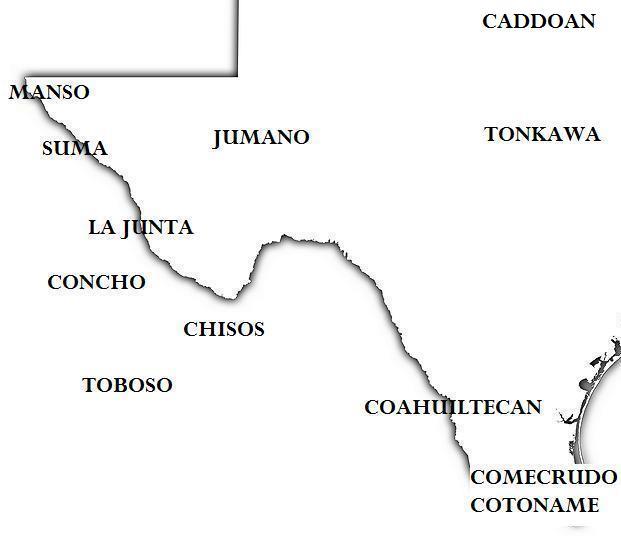The Jumano tribe holds a special place in the story of early Texas. Known as traders, guides, and cultural messengers, they connected the worlds of the Plains, Pueblos, and Rio Grande Valley long before Europeans arrived. Their adaptability, diplomacy, and vast trade routes made them one of the most influential Indigenous groups in Texas and the Southwest.
Origins and Where They Lived
View this post on Instagram
The name “Jumano” appears in Spanish records as early as the 1500s, though historians still debate whether it referred to one tribe or several closely related groups. What is certain is that the Jumanos lived across a wide stretch of West Texas, especially around La Junta de los Ríos, where the Rio Grande meets the Conchos River near present-day Presidio, Texas.
They also occupied parts of the Pecos River and Concho River valleys and traveled deep into the Big Bend region. Their territory formed a crucial crossroads between the desert Southwest, the Great Plains, and northern Mexico.
Three Distinct Ways of Life
Spanish explorers described at least three main Jumano groups, each adapted to its environment.
The La Junta Jumanos built villages near rivers, growing corn, beans, and squash while trading with nearby peoples. The Plains Jumanos followed buffalo herds across the open grasslands, relying on hunting and trading meat and hides. Farther west, Pueblo-associated Jumanos maintained ties with settled communities in New Mexico, exchanging goods such as salt, pottery, and textiles.
These groups were linked by trade and language, forming a flexible network that thrived across different landscapes.
Distinctive Appearance and Culture

The Jumanos were easily recognized by the lines and patterns they painted or tattooed on their faces and bodies, a practice noted by many early Spanish explorers. Their decorated appearance set them apart and helped others identify them during long trading journeys.
They were skilled at adapting to both river farming and Plains hunting, balancing agriculture with mobility. Their craftsmanship included woven goods, pottery, and tools made from buffalo bones and stone.
Trade Networks and Diplomacy
As expert traders, the Jumanos acted as middlemen among distant peoples. They carried buffalo meat, hides, and salt from the plains and desert to settled farming villages, returning with goods like corn, pottery, and textiles. Their trading routes stretched from Central Texas and New Mexico to Chihuahua, Mexico, making them an essential link between the north and south.
Through these exchanges, the Jumanos helped spread ideas, technologies, and even the early circulation of horses across the region.
Early Encounters with the Spanish
Some historians believe the Jumanos were among the first Native peoples to meet Europeans in Texas. The explorer Álvar Núñez Cabeza de Vaca, during his travels in the 1530s, described meeting tattooed traders near the Rio Grande who may have been Jumano.
Later Spanish expeditions in the late 1500s and 1600s—such as those led by Antonio de Espejo—reported friendly encounters with the Jumanos, who often served as guides. These early interactions opened the door for missions and settlements along the Rio Grande.
Challenges and Alliances in the 1600s
By the 1600s, the Jumanos faced new threats from Apache expansion and epidemics brought by Europeans. A well-known Jumano leader, Juan Sabeata, sought alliances with Spanish officials to establish missions and protect his people. Although missions were attempted, disease, displacement, and conflict weakened the tribe’s independence over time.
Still, the Jumanos remained skilled negotiators, balancing diplomacy with resistance as they tried to preserve their lands and way of life.
Dispersal and Decline
As the 1700s unfolded, warfare, forced relocation, and assimilation led many Jumanos to merge with other tribes such as the Tonks, Apaches, and Pueblos. By the mid-18th century, they had largely disappeared as a distinct tribe from Spanish records. Yet, their influence lived on through the communities that absorbed their traditions, languages, and stories.
Archaeological evidence from La Junta and the Pecos Valley continues to reveal traces of Jumano villages, trade goods, and farming techniques.
The Jumano Legacy in Texas
Though their name faded from the historical record, the legacy of the Jumano people endures across West Texas. Their role as traders, cultural connectors, and early allies to explorers helped shape the development of Texas long before it became a state.
Today, historians and archaeologists continue to uncover their story—one of resilience, adaptation, and far-reaching influence across the plains and deserts of Texas.


